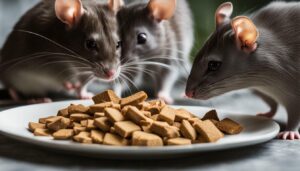Have you ever wondered if mice hibernate during the winter months? Contrary to popular belief, mice do not hibernate. These small rodents remain active throughout the year, even in colder temperatures. In fact, when winter arrives, mice become more determined in their quest for food and shelter, often seeking refuge in homes to escape the chill.
Key Takeaways:
- Mice do not hibernate during the winter but remain active, searching for food and shelter.
- They can enter homes for warmth and food, causing damage to property and creating health risks.
- Signs of a mouse infestation include gnawed or soiled food, home damage, droppings, runways, odors, and sounds.
- Mice are attracted to warm, dark places and homes that provide food, water, and shelter.
- To prevent mice infestations, seal off openings, keep food in sealed containers, and seek professional pest control if needed.
Understanding Mouse Hibernation Patterns
Mice have unique hibernation patterns that differ from other animals. Unlike bears or ground squirrels, mice do not enter a deep, prolonged state of hibernation during the winter months. Instead, they exhibit a behavior known as torpor.
Torpor is a temporary state of reduced activity and lowered metabolism that helps mice conserve energy when food sources are scarce or environmental conditions are unfavorable. During torpor, mice will decrease their body temperature and heart rate, but they are still capable of waking and foraging when necessary.
The duration of mouse hibernation, or torpor, can vary depending on the availability of food and the severity of the weather. Some mice may enter torpor for several hours each day, while others may remain in this state for longer periods. This flexibility allows them to adapt to changing conditions and survive during the winter months.
| Hibernation Behavior | Hibernation Duration | Hibernation Cycle |
|---|---|---|
| Torpor (reduced activity) | Several hours to longer periods | Varies depending on food availability and weather conditions |
Mice Hibernate Patterns
While mice do not undergo traditional hibernation, their hibernation patterns involve entering a state of torpor to conserve energy during the winter months. This behavior allows them to survive in cold environments where food sources may be limited.
Understanding mouse hibernation patterns can help homeowners identify signs of infestation and take appropriate action to prevent mice from entering their homes. By sealing off potential entry points and keeping food properly stored, you can reduce the risk of a mouse infestation and the associated damage to your property.
Remember, if you suspect a mouse infestation or are experiencing issues with rodents in your home, it is recommended to seek professional pest control services. They can safely remove the mice and implement measures to prevent their return, protecting your home and ensuring peace of mind.
The Truth About House Mice Hibernation
Contrary to popular belief, house mice do not go into hibernation mode during winter. These small rodents remain active, foraging for food and seeking shelter even in the coldest months. In fact, mice may try to enter homes to find warmth and a steady food source when temperatures drop.
Mice can cause significant damage to properties as they chew on support beams, wires, and insulation. Their presence also brings the risk of parasites and disease organisms into homes, posing potential health risks. It’s important to be aware of the signs of a mouse infestation, including gnawed or soiled food, damage to home goods, droppings, runways, trash accumulation, odors, and scratching or squeaking sounds.
Mice often nest in warm, dark places and are attracted to homes that provide warmth, food, water, and shelter. To prevent mice from entering your home, it’s crucial to seal off any potential openings. This includes door and window frames, utility lines, gaps in baseboards and foundation, vents, chimneys, and garage doors. By keeping food in sealed containers, you can also help minimize the chances of attracting mice into your living space.
Signs of a Mouse Infestation:
- Gnawed or soiled food
- Damage to home goods
- Droppings
- Runways
- Trash accumulation
- Odors
- Scratching or squeaking sounds
If you suspect a mouse infestation, it is highly recommended to seek professional pest control services to remove them and prevent their return. Professionals have the knowledge and expertise to handle infestations safely and effectively, ensuring the well-being of your home and family.
| Potential Entry Points to Seal | Prevention Tips |
|---|---|
| Door and window frames | Regularly inspect and repair any gaps or cracks |
| Utility lines | Seal entry points using weatherstripping or caulking |
| Gaps in baseboards and foundation | Fill holes and gaps with steel wool or expandable foam |
| Vents | Install screens or covers to prevent mouse entry |
| Chimneys | Ensure chimney caps are secure and intact |
| Garage doors | Seal gaps with weatherstripping and repair any damage |
Signs of Mouse Infestation in Winter
During winter, mice display specific behaviors as they seek refuge from the cold. These small rodents are known to enter homes in search of warmth, food, water, and shelter. Unfortunately, their presence can lead to property damage and health risks. It’s important to be aware of the signs of a mouse infestation so that you can take prompt action to address the problem.
One of the most common signs of a mouse infestation is gnawed or soiled food. Mice will chew through packaging to access food sources, leaving behind tiny teeth marks or droppings. You may also notice damage to your home goods, such as furniture and insulation, as mice are known to gnaw on these materials. Additionally, keep an eye out for small droppings scattered around your home, especially in areas where mice are likely to travel.
Other indicators of a mouse infestation include the presence of runways, which are paths mice create by repeatedly traveling along the same routes. You may find greasy smears or urine stains along these runways. Accumulated trash, such as shredded paper or cardboard, can also be a sign of a mouse infestation. Finally, be aware of any unusual odors or scratching and squeaking sounds coming from your walls or ceilings, as these may indicate the presence of rodents.
| Signs of Mouse Infestation | Description |
|---|---|
| Gnawed or soiled food | Chewed packaging, teeth marks, or droppings near food sources |
| Damage to home goods | Gnaw marks on furniture, insulation, or other materials |
| Droppings | Small, dark pellets scattered around the house |
| Runways | Greasy smears or urine stains along well-traveled paths |
| Trash accumulation | Shredded paper or cardboard used for nesting material |
| Odors and sounds | Unusual smells, scratching or squeaking noises |
If you suspect a mouse infestation, it’s crucial to take immediate action. Mice reproduce rapidly, and a small population can quickly escalate into a larger one. Professional pest control services can help remove existing mice and prevent their return. Remember to seal off openings in your home, such as cracks, gaps, and utility lines, to prevent mice from entering in the first place. Keeping food stored in sealed containers will also minimize potential attractants. By being proactive and vigilant, you can effectively prevent and address mouse infestations, ensuring the safety and well-being of your home and family.
Preventing Mouse Infestations
To keep mice out of your home, there are several preventive measures you can take. These simple steps can help protect your property from damage, keep your family safe from potential health risks, and maintain a clean and comfortable living environment.
First and foremost, it is important to seal off any openings that mice can use to enter your home. Inspect door and window frames for gaps, cracks, or holes, and use weatherstripping or caulking to seal them. Check utility lines, such as electrical and plumbing conduits, and seal any gaps or openings with steel wool or wire mesh. Pay close attention to gaps in baseboards and the foundation, as well as vents, chimneys, and garage doors. By blocking these entry points, you can significantly reduce the chances of mice finding their way into your home.
In addition to sealing off potential entry points, proper food storage is crucial in preventing mouse infestations. Mice are attracted to accessible sources of food, so it is important to keep your food stored in sealed containers. This includes pantry items, pet food, and even birdseed. By eliminating easy access to food, you remove one of the main reasons mice are attracted to homes.
If you suspect a mouse infestation or have seen any signs of mice in your home, it is recommended to seek professional pest control services. Mice multiply quickly, and their presence can escalate from a minor nuisance to a serious problem in a short amount of time. Pest control professionals have the expertise and resources to effectively remove mice from your home and implement preventative measures to keep them from returning.
| Preventive Measures: | Benefits: |
|---|---|
| Seal off openings and gaps in your home | Prevents mice from entering and reduces the risk of property damage |
| Store food in sealed containers | Eliminates a food source that attracts mice |
| Seek professional pest control | Ensures effective removal of mice and prevents their return |
By following these preventive measures and staying vigilant for any signs of mice, you can significantly reduce the risk of a mouse infestation in your home. Taking proactive steps to keep mice out not only protects your property but also promotes a healthier and more comfortable living environment for you and your family.
Conclusion
In conclusion, mice do not hibernate, and understanding their behavior during winter is crucial for effective pest control. While some animals go into a state of hibernation to conserve energy in cold temperatures, mice remain active throughout the year. As temperatures drop, these small creatures seek warmth and shelter, often finding their way into homes and buildings in search of food and a cozy place to nest.
Unfortunately, having mice in your home can lead to various issues. Mice can cause damage to your property by chewing on support beams, insulation, and electrical wires. They can also bring in parasites and disease organisms, posing health risks to you and your family. Therefore, it’s important to be aware of the signs of a mouse infestation so you can take prompt action.
Signs that you may have a mouse infestation include finding gnawed or soiled food, seeing droppings or runways, noticing a trash accumulation, detecting unfamiliar odors, or hearing scratching or squeaking sounds. These tiny pests like to nest in warm, dark places, so they may seek refuge in your home if it offers the necessary elements of warmth, food, water, and shelter.
To prevent mice from entering your home, it’s essential to seal off any potential entry points. This includes checking door and window frames, utility lines, gaps in baseboards and foundations, vents, chimneys, and garage doors for any openings. Additionally, keeping food stored in sealed containers will help deter them from invading your pantry. If you suspect a mouse infestation, it is recommended to seek professional pest control services. These experts can safely and effectively remove the mice from your home and help implement preventative measures to ensure they do not return.
FAQ
Do mice hibernate?
No, mice do not hibernate during the winter. They remain active, foraging for food and seeking shelter.
Can mice enter homes during the winter?
Yes, mice can enter homes for warmth and food when temperatures drop.
What kind of damage can mice cause to homes?
Mice can cause damage to property by chewing on support beams, wires, and insulation.
Do mice bring parasites and disease organisms into homes?
Yes, mice can bring parasites and disease organisms into homes.
What are the signs of a mouse infestation?
Signs of a mouse infestation include gnawed or soiled food, damage to home goods, droppings, runways, trash accumulation, odors, and scratching or squeaking sounds.
Where do mice nest in homes?
Mice nest in warm, dark places and are attracted to homes that provide warmth, food, water, and shelter.
How can I prevent mice from entering my home?
To prevent mice from entering your home, seal off openings such as door and window frames, utility lines, gaps in baseboards and foundation, vents, chimneys, and garage doors. Keeping food in sealed containers can also help prevent infestations.
What should I do if I have a mouse infestation?
If you have a mouse infestation, it is recommended to seek professional pest control to remove them and prevent their return.




